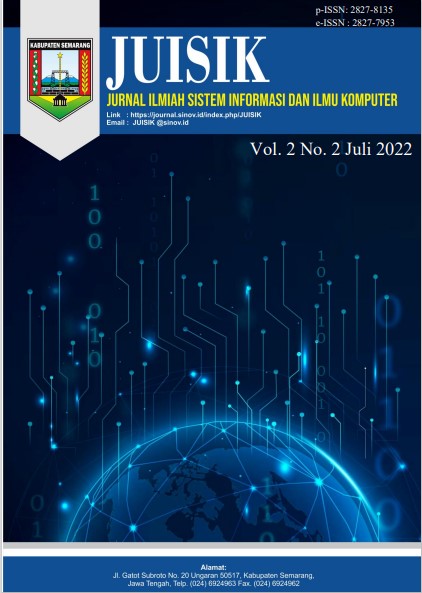Waveform Analysis Of Broadband Seismic Station Using Machine Learning Python Based On Morlet Wavelet
DOI:
https://doi.org/10.55606/juisik.v3i3.920Keywords:
earthquake clustering analysis, clustering algorithms—K-means, DBSCANAbstract
Wavelet signal processing is broadly used for analysis of real time seismic signal. The numerous wavelet filters are developed by spectral synthesis using machine learning python to realize the signal characteristics. Our paper aims to solve and evaluating the frequencies-energy characteristic of earthquake. The wavelet method by Continuous Wavelet Transform (CWT) is able to clearly and simultaneously of amplitudes and frequency-energy from component between the seismogram which seismic sensor broadband recorded in the January 16, 2017 in Medan, North Sumatra. Finally, from machine learning python with morlet wavelet allows good time resolution for high frequencies, and good frequency resolution for low frequencies
References
Arrizal, H. H., Sinambela, M., Widodo, Adi, S. P., & Frianto, H. T. (2023). Spatial cluster analysis of land seismicity in the northern part of Sumatra using the K-medoids algorithm. 2023 International Conference on Information Technology and Computing (ICITCOM), 181–185. https://doi.org/10.1109/ICITCOM60176.2023.10442535
Askari, S. (2021). Fuzzy C-Means clustering algorithm for data with unequal cluster sizes and contaminated with noise and outliers: Review and development. Expert Systems with Applications, 165, 113856. https://doi.org/10.1016/j.eswa.2020.113856
Chen, Y., Zhao, Y., Zhou, X., Xu, Z., & Liu, Q. (2021). KNN-BLOCK DBSCAN: Fast clustering for large-scale data. IEEE Transactions on Systems, Man, and Cybernetics: Systems, 51(6), 3939–3953. https://doi.org/10.1109/TSMC.2019.2956527
Cheng, D., Zhu, Q., Huang, J., Wu, Q., & Yang, L. (2019). A novel cluster validity index based on local cores. IEEE Transactions on Neural Networks and Learning Systems, 30(4), 985–999. https://doi.org/10.1109/TNNLS.2018.2853710
Darnila, E., Tarigan, K., Larosa, F. G. N., & Sinambela, M. (2021). Cluster analysis and seismicity partitioning for Northern Sumatera using machine learning approach. Journal of Theoretical and Applied Information Technology, 31(2). Retrieved from www.jatit.org
Di Martino, F., Pedrycz, W., & Sessa, S. (2018). Spatiotemporal extended fuzzy C-means clustering algorithm for hotspots detection and prediction. Fuzzy Sets and Systems, 340, 109–126. https://doi.org/10.1016/j.fss.2017.11.011
Hu, S. (2022). Fuzzy C-means clustering algorithm and its application in mental health intelligent evaluation system. 2022 IEEE Conference on Telecommunications, Optics and Computer Science (TOCS), 1305–1309. https://doi.org/10.1109/TOCS56154.2022.10016042
Huang, S., Kang, Z., Xu, Z., & Liu, Q. (2021). Robust deep K-means: An effective and simple method for data clustering. Pattern Recognition, 117, 107996. https://doi.org/10.1016/j.patcog.2021.107996
Ienco, D., & Bordogna, G. (2018). Fuzzy extensions of the DBScan clustering algorithm. Soft Computing, 22(5), 1719–1730. https://doi.org/10.1007/s00500-016-2435-0
Muhajir, M., & Sari, N. N. (2018). K-Affinity Propagation (K-AP) and K-Means clustering for classification of earthquakes in Indonesia. 2018 International Symposium on Advanced Intelligent Informatics (SAIN), 6–10. https://doi.org/10.1109/SAIN.2018.8673344
Saragih, N. F., Pratiwi, Y. Y., Jaya, I. K., Sarkis, I. M., Arrizal, H. H., & Sinambela, M. (2023). Clustering earthquakes in West Java using machine learning algorithm. 2023 International Conference of Computer Science and Information Technology (ICOSNIKOM), 1–4. https://doi.org/10.1109/ICoSNIKOM60230.2023.10364541
Shahapure, K. R., & Nicholas, C. (2020). Cluster quality analysis using Silhouette Score. 2020 IEEE 7th International Conference on Data Science and Advanced Analytics (DSAA), 747–748. https://doi.org/10.1109/DSAA49011.2020.00096
Sinaga, K. P., & Yang, M.-S. (2020). Unsupervised K-Means clustering algorithm. IEEE Access, 8, 80716–80727. https://doi.org/10.1109/ACCESS.2020.2988796
Vergani, A. A., & Binaghi, E. (2018). A soft Davies-Bouldin separation measure. 2018 IEEE International Conference on Fuzzy Systems (FUZZ-IEEE), 1–8. https://doi.org/10.1109/FUZZ-IEEE.2018.8491581
Vergara, V. M., Salman, M., Abrol, A., Espinoza, F. A., & Calhoun, V. D. (2020). Determining the number of states in dynamic functional connectivity using cluster validity indexes. Journal of Neuroscience Methods, 337, 108651. https://doi.org/10.1016/j.jneumeth.2020.108651
Vijay, R. K., & Nanda, S. J. (2019). A variable ε-DBSCAN algorithm for declustering earthquake catalogs. In Advances in Intelligent Systems and Computing (pp. 639–651). https://doi.org/10.1007/978-981-13-1592-3_50
Wang, X., & Xu, Y. (2019). An improved index for clustering validation based on Silhouette index and Calinski-Harabasz index. IOP Conference Series: Materials Science and Engineering, 569(5), 052024. https://doi.org/10.1088/1757-899X/569/5/052024
Wijaya, Y. A., Kurniady, D. A., Setyanto, E., Tarihoran, W. S., Rusmana, D., & Rahim, R. (2021). Davies Bouldin Index algorithm for optimizing clustering case studies mapping school facilities. TEM Journal, 1099–1103. https://doi.org/10.18421/TEM103-13
Zhao, Y., & Zhou, X. (2021). K-means clustering algorithm and its improvement research. Journal of Physics: Conference Series, 1873(1), 012074. https://doi.org/10.1088/1742-6596/1873/1/012074
Downloads
Published
How to Cite
Issue
Section
License
Copyright (c) 2023 Jurnal ilmiah Sistem Informasi dan Ilmu Komputer

This work is licensed under a Creative Commons Attribution-ShareAlike 4.0 International License.













